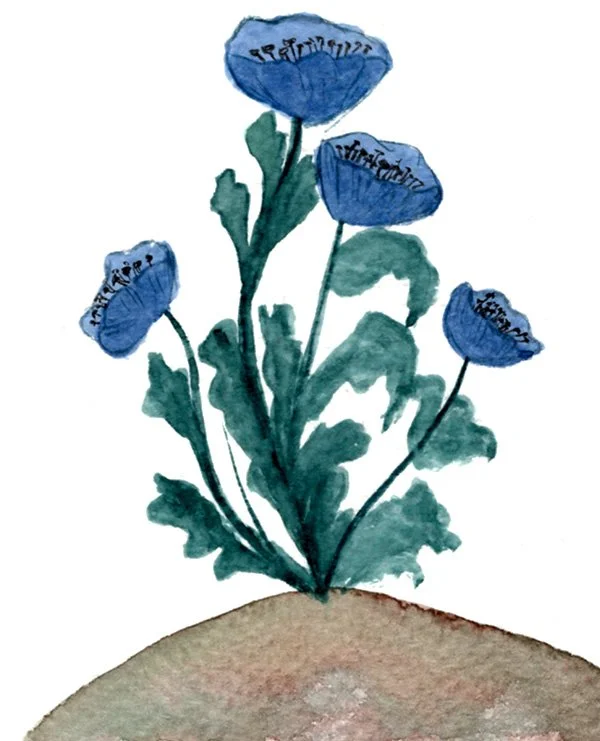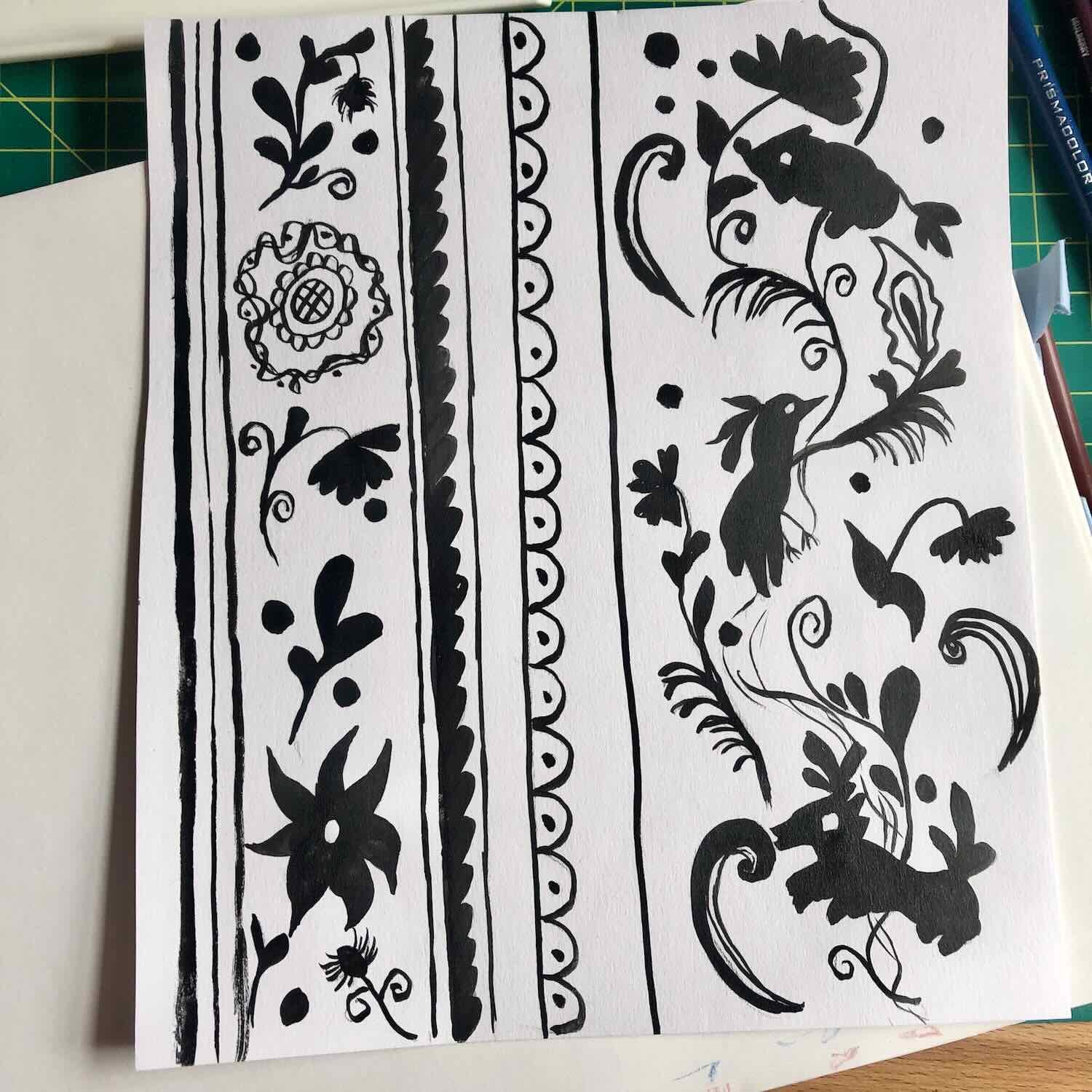My Illustration Process
Part 1: The Seed— Ideas, daydreams, and drafts
There can be many sources of inspiration for what eventually results in a finished project or illustration, but in truth, most of my work is full of the growth and sowing of many different seeds of ideas, questions, inspirations, feelings, experiences, and impressions. Sometimes I see something out in nature, or I go about my day and a thought comes or an impression of a picture, and often these are the start of many of the illustrations. Other times, there are themes or particular passages of books or colors or fragments of something that I mull over in my head for a long time–sometimes months or even years– that percolate and may eventually come together into a more cohesive vision.
Still-at any stage in which the ideas arrive, like planting seedlings in the spring, they must be cared for gently and persistently in order to grow, and given a good environment (sketchbooks, paper), nourishment (visual inspiration), and most importantly-time.
Part 2: Growing-Nourishment, water, and sunlight
Every project, just like every plant, grows at a wildly varying rate. There are some plants and projects which grow like lettuce or radishes and go from the idea stage to illustration rather quickly, (though this is not often for many of my personal projects-which tend towards bigger picture complexity and research). Other projects take more space and time to develop strong systems and complex growth patterns, like melons or chili peppers, or even small trees. And though I wish sometimes some creative endeavors would grow faster, they take the time they must take in order to gain the depth and inter-connections required to truly realize them.
For any of my creative projects- the growth stage is quite critical, but also very fun. It’s full of nourishing, tending, and watching the ideas grow. I pour a lot of research into my work, whether botanical, historical, cultural, or visual and I often can develop the details of the project the more I research, while also gaining a sense of stake in it. It’s also essential as an artist, to feed creative work in other ways- whether by playing around with materials, experimenting with making images and line and color, or by doing other activities like making good food, walking outside, reading books, and engaging with inspiration and daily life. These things are just as essential to the growth of projects, and many, many of my projects have become “unstuck” simply by walking outside, observing small bugs or plants, spending time with my dog, or being in the world in a different way.
At this stage, I do the sketching, research, measuring, experimenting, and often “failing” and needing to try new ways, in order to get more familiar with the concepts and project, and to understand it from different angles.
Part 3: Pruning-Compositions, colors, elements
After enough research, development, and drafts, I move onto the stage where I give the ideas and images some structure and support, which often involves what I like to call “pruning” or sometimes making selections and decisions. Because of the way my brain thinks in bigger-pictures, and great complexity and interdisciplinary connections, I often have to take a step back and make choices about what elements from that thinking and research that I want to appear in the final illustration, as sadly, there isn’t always room for everything. Luckily, though, a bit like plant cuttings, these can go on to make new creative projects further down the road.
At this stage, I like to play around with my watercolors to get a better sense of the overall mood and color range I want for the project. Sometimes, I have specific tones in mind like using a certain pink shade, or a particular pigment with a lot of texture and dimension, and others, require a bit of play to see how the colors react with one another and work together to tell the story. I love vibrancy and depth in my color work, but I do have to narrow the scope of color to achieve this, so I decide on certain pigments, and mixes, so that way as I am painting and mixing up colors on the go, I am picking from the same bases, so there is a sense of unity in the work.
Another way I like to give structure to my illustrations is by establishing the shape, composition, size, and placement of elements I’ve drawn. Though I’ve spent years studying compositions across many media (I have a degree in art history and have written far too many essays on composition….)I actually find composition to be challenging and I have to often use paper models to visually see the size of the illustration I want, and then play around with how the elements fit. I do like to experiment though, and I gain confidence too, by never making my compositions completely spot on and grid like. I rather like the human-element and quirkiness that comes from hand and free drawing my work. The structure I give to my illustrations through color, composition, and being deliberate about elements, but also leaving room for spontaneity, gives them their unique narrative quality.
Part 4: Bloom- Painting, Inking, Creating Magic
Once I have sketched out some faint outlines of my elements and composition with a light graphite watercolor pencil, I begin painting. Sometimes, I have the whole illustration mapped out and other times, I fill out the composition and make decisions as I go. Nothing can truly replicate the final paper and how colors and shapes look next to each other, as opposed to sketches.
I have fun with textures especially, granulation, mineral pigments, watercolor blooms, and the beautiful (and sometimes painstaking) work of layering watercolor and making unique color blends. I occasionally do ink on top or use ink as a painting medium on its own to make illustrations. Often though, my watercolors just receive a thin outline and details all done in watercolor with tiny brushes.
This part is so magical for me- I really get into the creative flow with it and it's by far, one of my favorite parts. It can be both nerve wracking and deeply joyous. Sometimes I work best to music or an audiobook, and often just to quiet.
Part 5: Harvest—Processing, Sharing, Storytelling
The last step of my illustration process is what I like to think of as a harvest, as with plants and farming, harvest is not necessarily completed all at once, and takes time, dedication, effort, patience, and community to achieve good results.
Once a painting is finished, it needs to be scanned, photographed, and digitized, in order for me to be able to share it on my website or social platforms, turn it into products or goods like books, prints, and more, or become part of a larger instillation, series, or creative vision. I scan and do very minimal color adjustments, if any are needed (and have to make sure pet hair did not make its way into the final!) and afterwards am able to use the final image for either its intended use in a product or project, or for telling stories with.
I consider this stage the storytelling part, because it’s where one takes the image or project and gets to share how it was made and the inspirations or process behind it. This is also where the illustrations often get received and seen by others and my art history self would know that how art is received and what people choose to make meaning of it and engage with it is as much as part of the story of the art as the original creator’s intentions and process. I share my pieces on my portfolio and blog, social channels, with people in my life, and am also hoping to make videos about some of the pieces this coming winter. Please stay tuned :)
Lastly, as a student of history, it would be remiss not to include the all-important but sometimes dreadful step or archival, which is honestly a process I am still trying to figure out. Not only does physical work get stored somewhere safe and protected, it's also very important to take notes about the colors used, the process, the stages involved, and maybe even more importantly the emotional journey that went alongside the art, new ideas sparked because of it, lingering questions or technical situations to resolve in the future. This stage honors the work and time put into each piece and ensures the ground is ready and prepared for the next seedlings to grow into beautiful creative gardens.
Thank you for taking the time to read about my process! If you are interested in seeing more of my work, please check out my portfolio or continue on to my blog where I share about my current and past creative projects and some parts of inspiration and life. I hope you have enjoyed this look into my creative process.
Wishing you a lovely day!
-Abbigail














